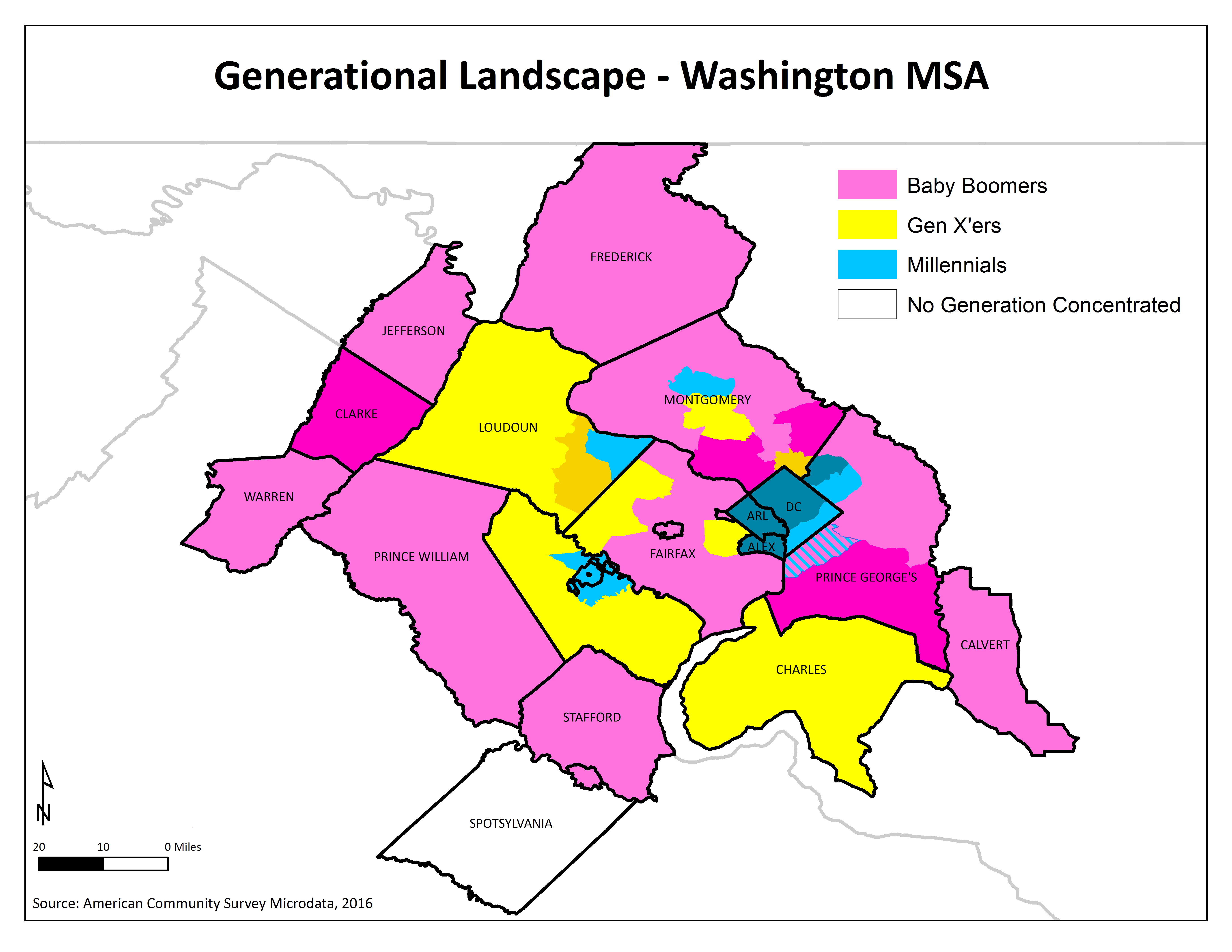Age matters a lot when it comes to predicting where someone lives. Looking at residential location patterns by age might help us predict future housing demand in different types of metros. A lot has been written about how Millennials are choosing to live in different places than earlier generations did and that Baby Boomers are downsizing and urbanizing at unprecedented rates. While few write about Gen X’ers—my cohort and the forgotten stepchild of demographics—it is important to understand their residential location patterns, too, if we want to understand the whole housing market.
Using microdata from the 2016 American Community Survey (ACS), I looked at the residential location patterns of three generations of residents in the Washington DC metropolitan area: Millennials (age 19 to 35 in 2016), Gen X’ers (age 36 to 51), and Baby Boomers (age 52 to 70). For each metro area, the share of Millennials, Gen X’ers and Baby Boomers in each area (defined by the Census Bureau’s Public Use Microdata Areas, or PUMAs) was compared to each generation’s share in the overall metro area population. Generation “hot spots” are identified as places where there is a relative high concentration of a particular generation. (Note: I used PUMAs instead of Census tracts because of sample size considerations.)
There are an estimated 6.7 million residents of the Washington DC metropolitan area, as defined in the ACS microdata. About a quarter of the region’s residents (23.8%) are Millennials, 22.7% are Gen X’ers, and 21.8% are Baby Boomers. (The rest of the population is made up by children age 18 and under and seniors over age 70.)

Millennials
Not surprisingly, the hot spots for Millennials are in the District of Columbia, Arlington and Alexandria, along with the College Park area in Prince George’s County. However, there are also concentrations of Millennials in perhaps unexpected places around the DC region, including Manassas, some parts of Prince George’s County, Germantown and northeast Loudoun County (e.g. Sterling). Some of these younger adults in suburban neighborhoods may be living in their parents’ homes but others are part of the group of young adult residents that have sought out more affordable housing in the region.
Because Millennials span the age range from 19 (i.e. many still in school) to 35 (i.e. many married with or without children), it is helpful to look separately at Younger Millennials (age 19 to 26) and Older Millennials (age 27 to 35). In the Washington DC region, Younger Millennials tend to be more concentrated in the District, as well as in communities where colleges are located (e.g. University of Maryland, George Mason University, University of Mary Washington).
Hot spots of Older Millennials include South Arlington, Alexandria, and northwest DC, but also include neighbors in more suburban jurisdictions, including northwest Prince George’s County, Springfield, Annandale and the southeastern portion of Fairfax County; and the Sterling area in Loudoun County.
Gen X’ers
Gen X’ers are more likely to live in the suburbs than are either younger or older Millennials. Relative to their share in the overall population, Gen X’ers are relatively highly concentrated in the Ashburn and Leesburg areas of Loudoun County and in southeastern Montgomery County, including Takoma Park. To a lesser extent, there are concentrations of Gen X’er hot spots in the close-in areas of Alexandria and south Arlington, as well as in Prince William County (e.g. Dale City), and the Centreville and Reston areas of Fairfax County.
Baby Boomers
Finally, compared to Millennials and Gen X’ers, Baby Boomers in the DC region tend to be more likely to live in Montgomery County, as well as in areas further from the region’s center. Hot spots for Baby Boomers include Bethesda and Potomac, as well as eastern Montgomery County. To a lesser extent, there are concentrations of Baby Boomers in the northern and western sections of Montgomery County, parts of Frederick County; Bowie, Laurel and Oxon Hill in Prince George’s County; McLean and Vienna in Fairfax County, the Laurel area of Prince George’s County; and in the further out Northern Virginia suburbs around Fredericksburg.
The patterns of residential locations by generation generally conform with expectations about housing needs and preferences, with Millennials more likely to live in the city where there are more apartments, Gen X’ers in the inner suburbs where there are more townhouses and smaller housing options, and Boomers in the more distant suburbs where there are larger single-family homes.
The data on older Millennials may be instructive in thinking about where Millennials might live as they get older. Concentrations of older Millennials—those age 27 to 35—include some suburban neighborhoods where homeownership might be more attainable.
Future blogs will explore in more detail the housing and residential location choices of Millennials, Gen X’ers and Baby Boomers in the DC region and in other parts of the country. If you’re looking for data for your community, we’d be happy to help – please reach out!










